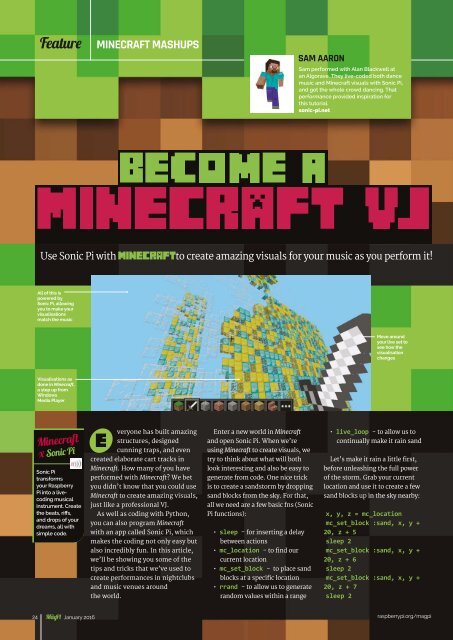Create successful ePaper yourself
Turn your PDF publications into a flip-book with our unique Google optimized e-Paper software.
Feature<br />
MINECRAFT MASHUPS<br />
SAM AARON<br />
Sam performed with Alan Blackwell at<br />
an Algorave. They live-coded both dance<br />
music and Minecraft visuals with Sonic Pi,<br />
and got the whole crowd dancing. That<br />
performance provided inspiration for<br />
this tutorial.<br />
sonic-pi.net<br />
Use Sonic Pi with<br />
to create amazing visuals for your music as you perform it!<br />
All of this is<br />
powered by<br />
Sonic Pi, allowing<br />
you to make your<br />
visualisations<br />
match the music<br />
Move around<br />
your live set to<br />
see how the<br />
visualisation<br />
changes<br />
Visualisations as<br />
done in Minecraft,<br />
a step up from<br />
Windows<br />
Media Player<br />
Minecraft<br />
x Sonic Pi<br />
Sonic Pi<br />
transforms<br />
your Raspberry<br />
Pi into a livecoding<br />
musical<br />
instrument. Create<br />
the beats, riffs,<br />
and drops of your<br />
dreams, all with<br />
simple code.<br />
veryone has built amazing<br />
structures, designed<br />
cunning traps, and even<br />
created elaborate cart tracks in<br />
Minecraft. How many of you have<br />
performed with Minecraft? We bet<br />
you didn’t know that you could use<br />
Minecraft to create amazing visuals,<br />
just like a professional VJ.<br />
As well as coding with Python,<br />
you can also program Minecraft<br />
with an app called Sonic Pi, which<br />
makes the coding not only easy but<br />
also incredibly fun. In this article,<br />
we’ll be showing you some of the<br />
tips and tricks that we’ve used to<br />
create performances in nightclubs<br />
and music venues around<br />
the world.<br />
Enter a new world in Minecraft<br />
and open Sonic Pi. When we’re<br />
using Minecraft to create visuals, we<br />
try to think about what will both<br />
look interesting and also be easy to<br />
generate from code. One nice trick<br />
is to create a sandstorm by dropping<br />
sand blocks from the sky. For that,<br />
all we need are a few basic fns (Sonic<br />
Pi functions):<br />
• sleep - for inserting a delay<br />
between actions<br />
• mc_location - to find our<br />
current location<br />
• mc_set_block - to place sand<br />
blocks at a specific location<br />
• rrand - to allow us to generate<br />
random values within a range<br />
• live_loop - to allow us to<br />
continually make it rain sand<br />
Let’s make it rain a little first,<br />
before unleashing the full power<br />
of the storm. Grab your current<br />
location and use it to create a few<br />
sand blocks up in the sky nearby:<br />
x, y, z = mc_location<br />
mc_set_block :sand, x, y +<br />
20, z + 5<br />
sleep 2<br />
mc_set_block :sand, x, y +<br />
20, z + 6<br />
sleep 2<br />
mc_set_block :sand, x, y +<br />
20, z + 7<br />
sleep 2<br />
24 January 2016 raspberrypi.org/magpi


